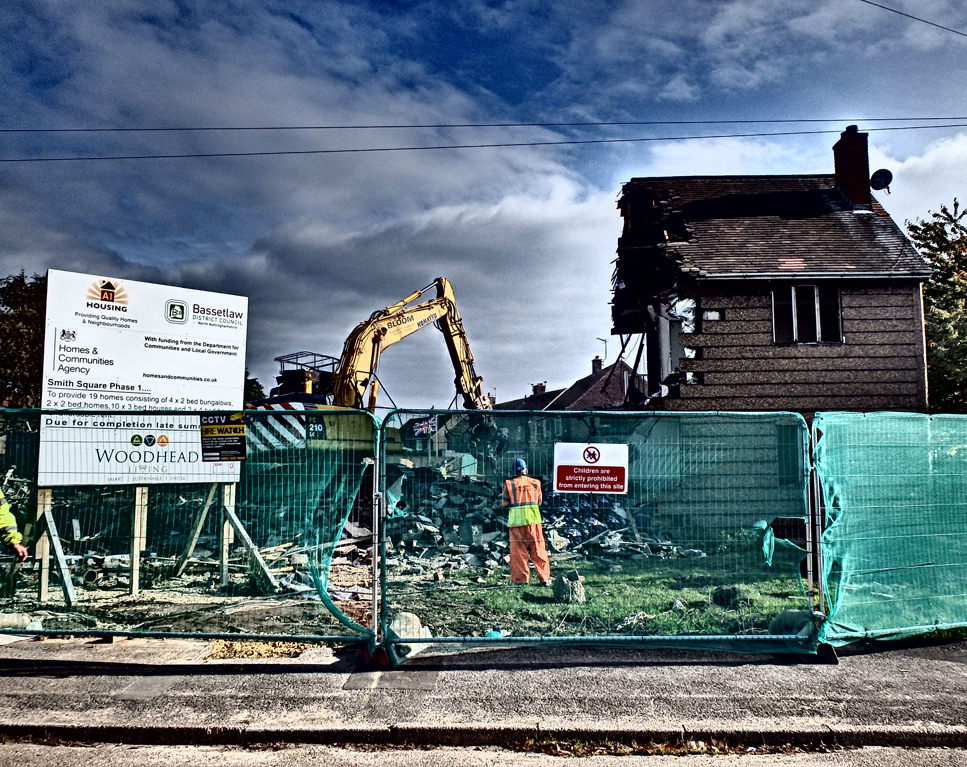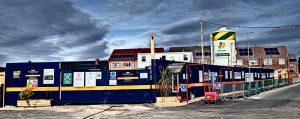
When it comes to creating a successful formula for new social housing, A1 Housing and Bassetlaw District Council may just have cracked it. Claire Clutten reports on a new development in Harworth that is ‘keeping it local’.
Harworth is a small rural town in Nottinghamshire within the jurisdiction of Bassetlaw District Council, with a close-knit community and a strong mining heritage. Harworth Colliery was mined for 86 years, producing coal for the power stations on the River Trent until its closure in 2003. The town was also home to cycling legend Tommy Simpson, World Champion in 1965 whose father was a miner and moved to Harworth from County Durham to work at the colliery.
For a quarter of a century, no new council homes were built in Harworth, however in 2014, plans were set in motion to change that, thanks to a pioneering new development spearheaded by A1 Housing and Bassetlaw District Council, that in 2015 saw Woodhead Group successfully deliver Phase One of a major three phase council housebuilding programme in the town.
The three-year programme is valued at £7.5m and will see 71 new homes constructed on Smith Square and Thompson Avenue to replace defunct Airey Houses built after the Second World War and to bolster A1 Housing’s stock. The properties are being built to Code for Sustainable Homes Level 4 and Lifetime Homes. Funding for the project comes from Bassetlaw District Council, with an additional £1.7m from the HCA.
The properties are a mix of two and three-bedroom semi-detached houses, four-bedroom detached houses and twobedroom semi-detached bungalows, in addition to one-bedroom flats.
Existing housing
Reaching the end of their usable life and suffering from poor thermal properties, the existing houses were expensive for residents to heat and were becoming a costly maintenance headache for ALMO A1 Housing, as technical and design manager Kenay Reshad points out: “With the Airey houses, we had to carry out regular Boroscope Surveys to determine how much the concrete columns were deteriorating.

“Within each column there is a tubular steel reinforcing bar which was prone to rusting, which caused the concrete surrounding it to crack and fragment, ultimately leading to the loss of the column’s structural integrity. With the number of properties we had in the district it was costing us in the region of £12,000 per annum to carry out all the surveys.”
A1 Housing had originally earmarked £30,000 to £40,000 to improve the houses, however with the properties only expected to last another 10 years, it was deemed a better use of resources to demolish them and reinvest the money into building modern energy-efficient new homes instead.
The project was put out to tender through a mini competition via the EEM (Efficiencies East Midlands) framework, a procurement consortium for local authorities and social housing providers in the region. SME construction company Woodhead Group priced the scheme and successfully submitted a tender.
What particularly impressed both the council and A1 was the quality submission the company put forward. It included facts and figures detailing how Woodhead intended to procure the site through local employment initiatives, local labour and wherever possible, utilising a local supply chain. As an example, the M&E consultants and window supplier on this project both hail from Harworth.
Woodhead believes it’s really important to give something back to the local communities it serves, as construction director Craig Pygall elaborates: “The council is providing the funds for us to build this tremendous estate and we’re using local people to work here, so we’re putting the money back into their constituents.”
Construction work
On site works for the 19 units in Phase One began in September 2014 and the first properties were handed over in July/August of last year. Phase Two, which commenced in September 2015, is progressing well, this involved the demolition of the rest of the Airey houses on Smith Square to create 24 new properties. These properties will be ready for residents to move into May/June 2016.
Luke Downing, senior project manager at Woodhead Group, comments: “All the new housing is direct decant tenants housing. We built 19 properties and then decanted the existing tenants out of Smith Square into their new homes, which allowed us to free up the next phase of properties for demolition.
“Because we were involved in two existing communities, what became clear in Phase One was that if we accelerated six units out of Phase Two, we could decant everyone pretty much in one go, thus keeping the community together, enabling us to demolish all the existing properties at the same time. If we’d left it how it was, we would have ended up with people pepper potted around an existing street with derelict housing.
“By holding resident involvement meetings, we’ve been able to capture people’s specific needs and build them bespoke houses. It’s been really good.”
Another feature peculiar to this development is the size of the properties; they are much bigger than a standard unit. Luke says: “We’re matching the need of what the tenants require.”
A prime example is a family of eight who previously lived in a three-bedroom property in Smith Square, with the parents occupying one bedroom, five daughters in another and a son in the box room. The cramped quarters were in a serious state of deterioration, not exactly the healthiest of living environments. The family’s new home is much more spacious and better equipped to meet their needs.
Kenay Rashad adds: “At the time [of starting the project] there wasn’t a definitive national standard for room/houses sizes, so we combined the RIBA (The Case For Space, Homewise) and the GLA London Housing Design Guide (Mayor of London) which gave us a larger and more comfortable house design.”

The existing houses on both Smith Square and Thompson Avenue occupy generous plots. This enabled the project partners to create houses with bigger footprints — whilst still retaining a good amount of outdoor recreational space — with off street parking, not every redevelopment is as fortunate. All the new houses have lockable sheds in the gardens too.
Changing perceptions
The quality of the build is extremely high and crucially, community buy-in is strong. The delivery partners have been liaising with residents and engendering support for the development from an early stage and this shows.
The newly built houses benefit from energy-efficient heating systems and also incorporate renewable technology. A great deal of attention has been paid to the build process to reduce any potential for heat loss. The latest sprinkler systems have also been installed and SBD certified fire doors fitted.
Luke comments: “Residents were given a lot of choice in terms of kitchen units, flooring, things like that, we’ve tried to make the process as smooth as possible.”
Craig makes an extremely valid point: “Its not just about building houses, you’re building homes.”
Kenay adds: “What we’ve tried to do is design modern, energy-efficient houses which reflect the characteristics and architectural details of the surrounding area with a variety of brick and roof tile colours that would look like a modern housing development, rather than mimic the old council estates of the past.”
And to this end, Kenay says: “We’ve had people driving up to the site and asking for the location of the show house, because they thought it was a private development.”
Paul Pygall, Woodhead’s site manager, concurs: “Everybody you speak to, from delivery drivers to the contractors that come on site, cannot believe it’s a council development.”
Cllr June Evans, cabinet member for finance at Bassetlaw District Council and a Harworth Ward Member, adds: “What the local people are really impressed with, is not just that it’s a mixture, so it doesn’t look like one row of council houses, but because the bricks are slightly different shades, as are the roof tiles, it makes every house look individual and attractive.”
Apprenticeship opportunities
Craig tells LABM: “Between 80 and 90% is sourced within a 40 mile radius of the site, within 20 miles I think we’re well over 60%, that’s both for local spend and local labour.”
Luke adds: “Over the lifecycle of the project we’ve been tasked with creating three job ppportunities, we’ve secured two of these and both are A1 Housing tenants. When we started on the scheme we were approached by Craig Milns who lives on the existing housing in Smith Square, he started initially as a labourer and progressed through to being an assistant site manager. We’ve also got a labourer, Nick Middleton, who came into the process half way through. His was one of the houses we demolished and he now lives in one of the four-bedroom properties.”

Craig says: “We looked at the social benefits the development could bring, it’s not just about local employment and monitoring the local spend, beyond that it’s about engaging with young people to get them passionate about construction.”
Over the life of the project Woodhead has committed to 80 one-week work placements. The SME is also working in partnership with North Notts College, giving construction students the opportunity to participate in practical site placement schemes. One of the construction and joinery apprentices in particular has impressed the project partners. Craig says: “Jayden has shown a real appetite to want to move forward with us as an assistant site manager. It’s inspirational for me to see these young people, who show that appetite.”
Jayden made his mark by helping a family with a cooker that was too big to fit into the kitchen of their temporary three-bed accommodation. Despite it not being part of the original scope of works Jayden took it upon himself to alter the kitchen to make the equipment fit.
Craig says: “Jayden knows the family. It’s going to make a massive difference to them. Rather than having an external trade come in, which would cost them extra, we’re here, it’s for the clients, let’s get it sorted.”
Brave decision
Craig concludes: “A1 Housing put this out as a three-year development. If you consider an apprenticeship is a three-year course, that allowed us when looking at the tender to say we can really make a difference here, engaging with colleges, getting apprentices on site, getting the local residents employed by Woodhead Group and local firms, they can see a future of three-years worth of works. There was no guarantee for the third phase because A1 Housing was still waiting on some funding and we wanted to support that, so I think it was a brave step for them to take and a very clever one to be honest.”
Woodhead intends to create a new playground in Phase Three to provide a meaningful space that matches the needs of the residents, predominantly young families. This will replace the green amenity space lost to the new development. The new street, which will be created during Phase Three, will be named Simpson Walk, after famous local cyclist Tommy Simpson.

The town’s prospects are certainly looking up, the area has been awarded Housing Zone Status to build as many as 1,500 homes on the former colliery site. Cllr June adds: “There’s also an application in for a big business park, it’s going to be massive and that to me says jobs and that’s good.”
What Woodhead, A1 Housing and Bassetlaw District Council are striving to achieve in Harworth is very special, something the partners are extremely passionate about — high quality social housing built by local people for local people. Working hard to keep the existing community together is paying dividends.
Social inclusion is high, with local people an integral part of the process, thanks to the partnership offering them greater choice over fixtures and fittings, making the homes more bespoke and providing apprenticeship opportunities, strengthening the already tight-knit community and instilling a deeper sense of pride. “Homes with principles built on them,” says Cllr Evans.








